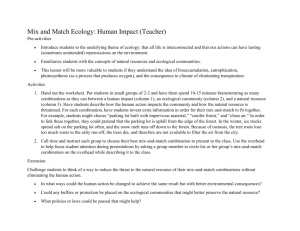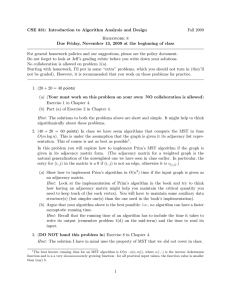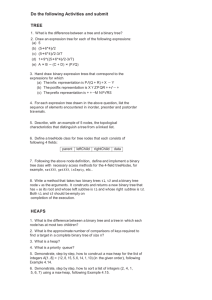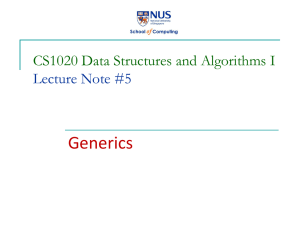Mix-and-Match
advertisement
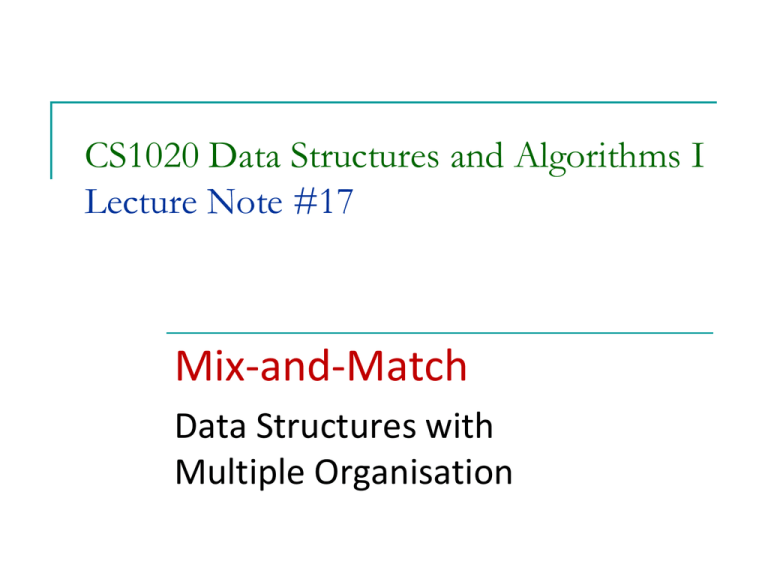
CS1020 Data Structures and Algorithms I Lecture Note #17 Mix-and-Match Data Structures with Multiple Organisation Basic Data Structures Arrays Linked Lists Trees (to be covered in CS2010) We can combine them to implement different data structures for different applications. [CS1020 Lecture 17: Mix-and-Match] 2 Mix-and-Match Array of Linked Lists E.g.: Adjacent list for representing graph E.g.: Hash table with separate chaining 1 2 3 [CS1020 Lecture 17: Mix-and-Match] 3 Adjacency List for Directed Graph 1 2 2 4 3 2 v1 3 v3 4 4 5 v2 4 v5 v4 G [CS1020 Lecture 17: Mix-and-Match] 4 Adjacency Matrix for Directed Graph Matrix[i][j] = 1 if (vi, vj)E 0 if (vi, vj)E 1 2 3 4 5 v1 v2 v3 v4 v5 1 v1 0 0 0 0 0 2 v2 1 0 1 0 0 3 v3 0 0 0 0 1 [CS1020 Lecture 17: Mix-and-Match] 4 v4 0 1 1 0 1 5 v5 0 0 0 0 0 v2 v1 v3 v5 v4 G 5 CS1102 AY2003 [CS1020 Lecture 17: Mix-and-Match] 6 CS1102 AY2003: Use Adjacency Matrix Operation Big-O insert(i, j) O(1) 1 delete(i, j) O(1) 2 T exists(i, j) O(1) 3 neighbours(i) O(n) 4 T [CS1020 Lecture 17: Mix-and-Match] 1 2 T 3 4 T T 7 CS1102 AY2003: Use Adjacency List Operation Big-O insert(i, j) O(1) 1 2 3 delete(i, j) O(n) exists(i, j) O(n) neighbours(i) O(ni) [CS1020 Lecture 17: Mix-and-Match] 4 8 Problem Searching on an unsorted linked list is O(n) How to improve it to O(1)? Use hashing. (i, j) as key and the hash value returned by hash function to be index to a hash table where (i, j) is stored together with the reference to the node in the linked list. [CS1020 Lecture 17: Mix-and-Match] 9 Use Adjacency List Operation Big-O insert(i, j) O(1) 1 2 3 delete(i, j) O(n) exists(i, j) O(1) neighbours(i) [CS1020 Lecture 17: Mix-and-Match] O(ni) 4 Is delete (i, j) O(1)? 10 CS1102 AY2003 Build an adjacency list of the graph, where the lists are doubly linked. Build a hash table with (i, j) as key, and a reference to the node representing (i, j) in the adjacency list as value. [CS1020 Lecture 17: Mix-and-Match] 11 End of file
